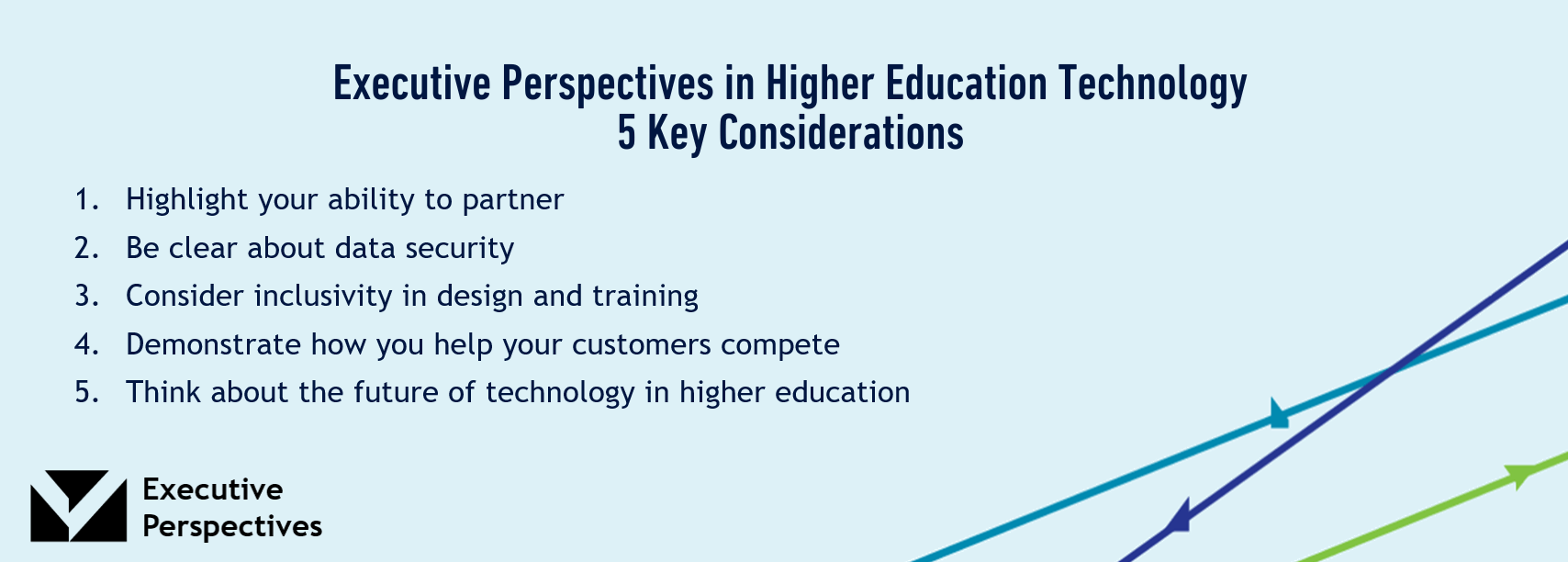
We hosted an hour-long panel discussion featuring IT leaders from some of the UK’s leading universities. They shared their thoughts on higher education technology priorities, challenges, and trends. Here are a few of our takeaways.
 1. Highlight your ability to partner
1. Highlight your ability to partner
Summary: Our panel of higher education IT leaders shared that they don’t just want suppliers. They want partners - someone who’s willing to invest time to understand the challenges of administrative and academic communities, who’s willing to share their own challenges, and who can collaborate with them to reach desired results. For these leaders, it’s not just about technology but about relationships, behaviors, and communication, too.
Ask yourself: What else can we do to help customers feel like partners? Do our case studies highlight our ability to partner?
 2. Be clear about data security
2. Be clear about data security
Summary: With malicious actors, looking to expose weaknesses in systems, University IT departments continue to prioritise data security and digital well-being for students and staff. Our panelists spoke about the challenge of balancing security with usability. Some current considerations include multi-factor authentication, identity and access management, and virtual machines for work that is sensitive. In the future, these thought-leaders see an opportunity to leverage machine learning and artificial intelligence to stay ahead of cyber terrorists.
Opportunity: With a lot of niche groups, identity and access control can be a particular challenge in the higher education environment, how can we support complex sets of privileges in a streamlined way?
 3. Consider inclusivity in design and training
3. Consider inclusivity in design and training
Summary: As University IT leaders are working to help provide a rich university experience in a blended (online / face-to-face) world, the emphasis on inclusivity and equity has grown stronger. There is an understanding that not all people have access to the same tools in the same ways. To combat this challenge, IT departments have begun to offer even greater support to students, faculty, and staff around digital competencies and skills, helping educate people on how to work effectively online.
Food for Thought: In sales and marketing, it’s common to talk about buyer personas. But often buyers aren’t the same as end users. To better inform the user experience, should we be thinking more about end user personas too? How can we show buyers that we understand their end users and can provide support for their goals and challenges with inclusivity?
 4. Demonstrate how you help your customers compete
4. Demonstrate how you help your customers compete
Summary: As universities compete to attract students, IT departments are thinking about how they can help. They are working to provide back- and front-end solutions that support a highly regarded student experience. This includes prioritising a seamless user experience with concepts like SSO and system integrations, and looking beyond systems of record to what leading research and advisory firm, Gartner, calls systems of differentiation and innovation.
Ask Yourself: How does our solution help our customers compete to attract students? Do we support positive student experiences? Does it make sense to highlight the student perspective in our sales and marketing communications?
 5. Think about the future of higher education technology
5. Think about the future of higher education technology
Summary: Technology trends like artificial intelligence, machine learning, and big data certainly have a place in powering some of the world’s leading research but when it comes to the administrative and education side of higher education, they have a place there, too. Our panelists shared visions about concepts like the personalisation of learning, and AI and machine learning for cyber security. They also shared realities like the use of big data for scenario planning, the use of smart speakers for students to find out exam grades or what time the pub opens, and how data analytics can support proactive student interventions.
Opportunity: Perhaps the true opportunity all goes back to the idea of partnerships. Understanding the technology is one thing but the success really comes in understanding how that technology can solve our customers (partners) biggest challenges and support higher education goals like enabling positive student experiences and world-class research.







